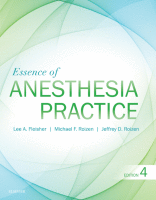Physical Address
304 North Cardinal St.
Dorchester Center, MA 02124

Risk Risk of aspiration: Approximately 3 per 10,000 anesthetics, 11 per 10,000 emergency and/or after-hours cases, and 29 per 10,000 emergency cases in ASA IV and V pts Loss of protective reflexes and sphincter function Obstructed or abnormal GI motility…

Risk Arnold-Chiari malformation (Chiari Malformation type II or CMII) is found exclusively in pts with myelomeningocele. Myelomeningocele occurs in 0.6 of 1000 live births. Perioperative Risks Vocal cord paralysis Respiratory distress Apnea Neurogenic dysphagia and pulmonary aspiration Hydrocephalus and increased…

Risk One of most common abdominal emergencies Possible at any age but most common during an individual’s teens and 20s 11 in 10,000 individuals will experience appendicitis M:F ratio 1.4:1 Most common reason for nonobstetric surgery during pregnancy; Occurs in…

Risk Full-term infants with an underlying pathology (i.e., neurologic disorders, metabolic derangements) Premature infants, with or without an underlying pathology Infants less than 60 wk post conceptual age Underweight infants <1000 g Anemia Perioperative Risks More prone to apnea during…

Risk 15:1,000,000 live births Equal M:F ratio Perioperative Risk Aspiration Bronchospasm Resp depression Airway obstruction Worry About Difficult mask, airway, or IV access Elevated intracranial pressure, temperature dysregulation, and seizures Corneal abrasions (due to exophthalmos) PACU and perioperative monitoring for…

Risk Most common valvular heart disease; prevalence only 0.2% among adults aged 50-59 y, but increases to almost 10% after age 80 y. Calcific aortic stenosis: Major risk factors are increasing age, LDL, diabetes mellitus, smoking, hypertension, and bicuspid valve…

Risk There are on the order of 100,000 aortic valve surgeries each year, with approximately 18,000 of them performed annually in the USA. Of aortic valves, 20% to 30% have isolated regurgitation at time of replacement. At time of replacement,…

Risk Lifetime prevalence approximately 30% in USA Gender: Female (2× more likely compared with male) Environmental: Traumatic or stressful events Age: Often develop in childhood and early adulthood; however, may occur any time after a stressful event Medical conditions: Chronic…

Risk Incidence in USA: 1:2000-5000 (may be higher) Men and women equally affected and no racial or ethnic difference Perioperative Risks Risk of postop thromboembolic phenomena; 40% to 70%, most common (in descending order): DVT, pulm embolus, mesenteric thrombosis, cerebral…

Risk Pts with mechanical heart valves, atrial fibrillation, pulm embolism, or recent venous thrombosis. Oral anticoagulant therapy (warfarin, oral Xa inhibitor-rivaroxaban, apixaban, and edoxaban) and direct thrombin inhibitor (dabigatran) and use of low-molecular-weight heparin, fondaparinux may increase potential risks in…